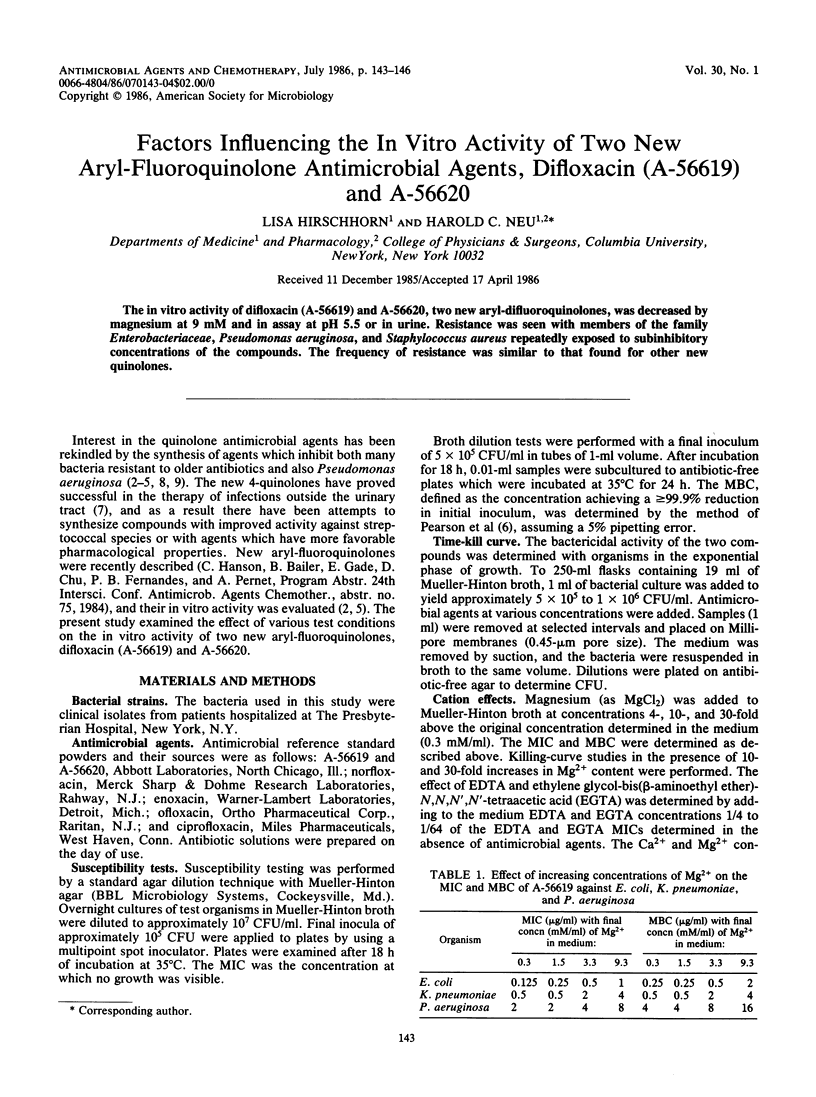Abstract
The in vitro activity of difloxacin (A-56619) and A-56620, two new aryl-difluoroquinolones, was decreased by magnesium at 9 mM and in assay at pH 5.5 or in urine. Resistance was seen with members of the family Enterobacteriaceae, Pseudomonas aeruginosa, and Staphylococcus aureus repeatedly exposed to subinhibitory concentrations of the compounds. The frequency of resistance was similar to that found for other new quinolones.
Full text
PDF



Selected References
These references are in PubMed. This may not be the complete list of references from this article.
- Barry A. L., Jones R. N., Thornsberry C., Ayers L. W., Gerlach E. H., Sommers H. M. Antibacterial activities of ciprofloxacin, norfloxacin, oxolinic acid, cinoxacin, and nalidixic acid. Antimicrob Agents Chemother. 1984 May;25(5):633–637. doi: 10.1128/aac.25.5.633. [DOI] [PMC free article] [PubMed] [Google Scholar]
- Barry A. L., Thornsberry C., Jones R. N. In vitro evaluation of A-56619 and A-56620, two new quinolones. Antimicrob Agents Chemother. 1986 Jan;29(1):40–43. doi: 10.1128/aac.29.1.40. [DOI] [PMC free article] [PubMed] [Google Scholar]
- Chin N. X., Neu H. C. Ciprofloxacin, a quinolone carboxylic acid compound active against aerobic and anaerobic bacteria. Antimicrob Agents Chemother. 1984 Mar;25(3):319–326. doi: 10.1128/aac.25.3.319. [DOI] [PMC free article] [PubMed] [Google Scholar]
- Chin N. X., Neu H. C. In vitro activity of enoxacin, a quinolone carboxylic acid, compared with those of norfloxacin, new beta-lactams, aminoglycosides, and trimethoprim. Antimicrob Agents Chemother. 1983 Nov;24(5):754–763. doi: 10.1128/aac.24.5.754. [DOI] [PMC free article] [PubMed] [Google Scholar]
- Eliopoulos G. M., Moellering A. E., Reiszner E., Moellering R. C., Jr In vitro activities of the quinolone antimicrobial agents A-56619 and A-56620. Antimicrob Agents Chemother. 1985 Oct;28(4):514–520. doi: 10.1128/aac.28.4.514. [DOI] [PMC free article] [PubMed] [Google Scholar]
- Pearson R. D., Steigbigel R. T., Davis H. T., Chapman S. W. Method of reliable determination of minimal lethal antibiotic concentrations. Antimicrob Agents Chemother. 1980 Nov;18(5):699–708. doi: 10.1128/aac.18.5.699. [DOI] [PMC free article] [PubMed] [Google Scholar]
- Ramirez C. A., Bran J. L., Mejia C. R., Garcia J. F. Open, prospective study of the clinical efficacy of ciprofloxacin. Antimicrob Agents Chemother. 1985 Jul;28(1):128–132. doi: 10.1128/aac.28.1.128. [DOI] [PMC free article] [PubMed] [Google Scholar]
- Sanders C. C., Sanders W. E., Jr, Goering R. V., Werner V. Selection of multiple antibiotic resistance by quinolones, beta-lactams, and aminoglycosides with special reference to cross-resistance between unrelated drug classes. Antimicrob Agents Chemother. 1984 Dec;26(6):797–801. doi: 10.1128/aac.26.6.797. [DOI] [PMC free article] [PubMed] [Google Scholar]
- Sato K., Matsuura Y., Inoue M., Une T., Osada Y., Ogawa H., Mitsuhashi S. In vitro and in vivo activity of DL-8280, a new oxazine derivative. Antimicrob Agents Chemother. 1982 Oct;22(4):548–553. doi: 10.1128/aac.22.4.548. [DOI] [PMC free article] [PubMed] [Google Scholar]
- Seibert G., Klesel N., Limbert M., Schrinner E., Winkler I. Die antibakterielle Aktivität in vitro von Ofloxacin im Vergleich mit anderen oral verabreichbaren antimikrobiellen Substanzen bei Ampicillin-resistenten klinischen Isolaten. Arzneimittelforschung. 1984;34(11):1552–1554. [PubMed] [Google Scholar]


